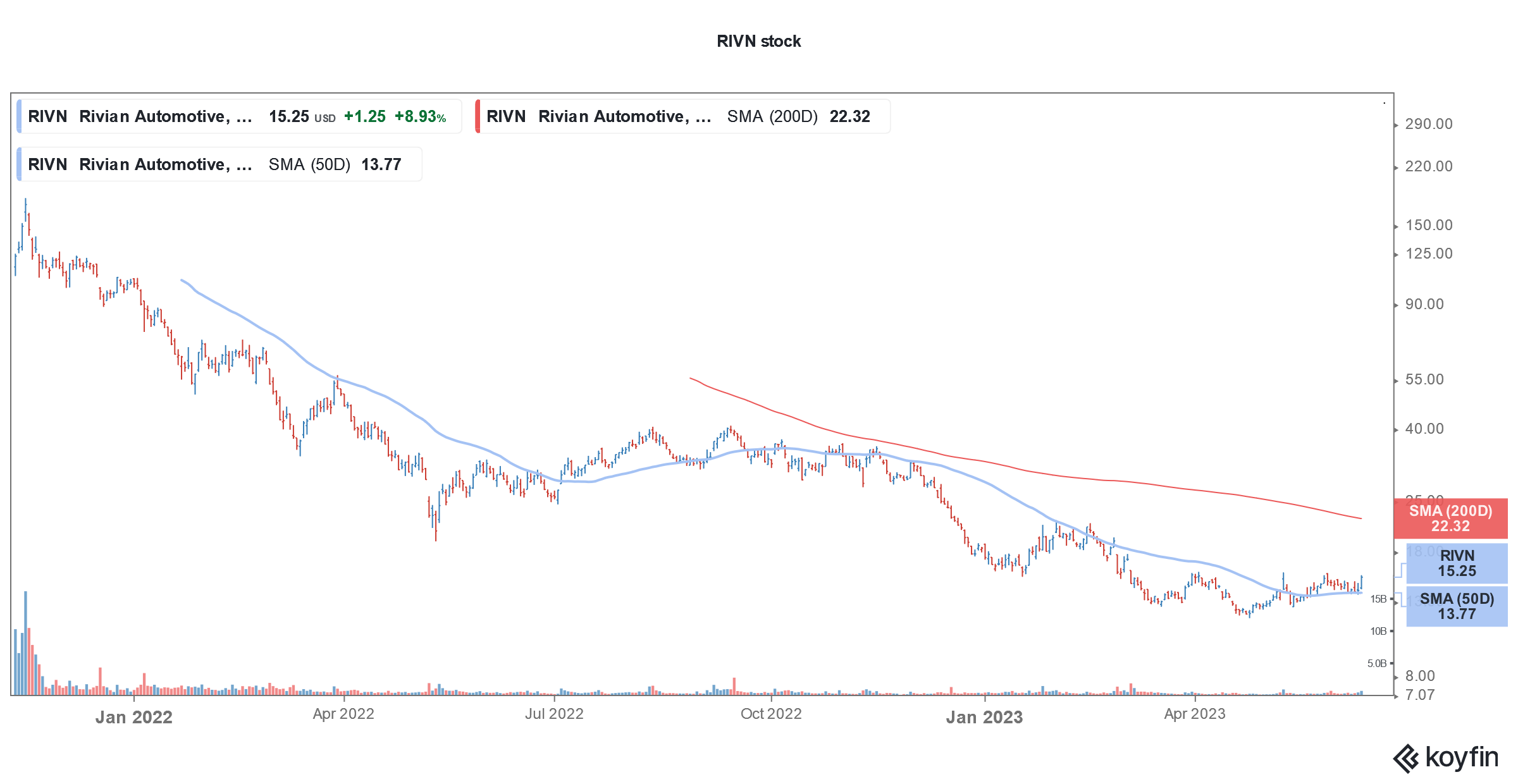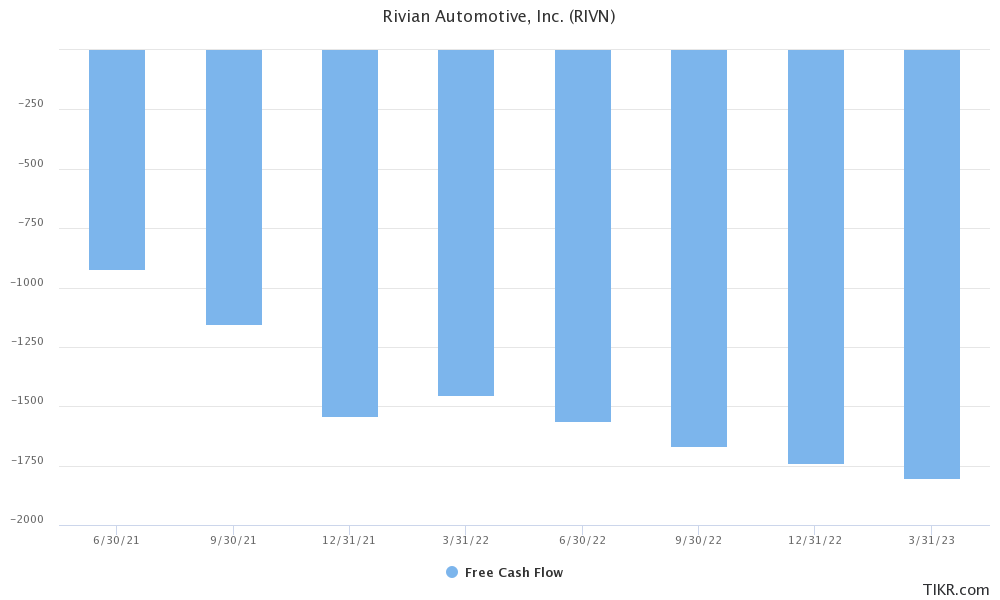Rivian to Lose Its Position in Nasdaq 100 Index as Stock Price Crashes
Please note that we are not authorised to provide any investment advice. The content on this page is for information purposes only.
The Nasdaq has confirmed that startup EV (electric vehicle) company Rivian (NYSE: RIVN) would lose its position in the coveted Nasdaq 100 Index and would be replaced by ON Semiconductors.
The Nasdaq 100 is a market cap-weighted index and decides the constituents based on their market cap. In Rivian’s case, it was among the smallest constituent of the index with a weightage of less than 0.1% at the end of both April and May.
The index typically boots out stocks that constitute less than 0.1% of the index for two straight months.
Rivian would lose its position in Nasdaq 100 on June 20
To be sure, Nasdaq booting out Rivian hasn’t exactly come out from the blues and earlier this month, JP Morgan analyst Min Moon predicted in a note that Nasdaq might remove Rivian amid its falling weightage in the index.
Rivian stock is down 12% so far in 2023 while the Nasdaq 100 has gained around 35% over the period. The tech-heavy index is outperforming the S&P 500 by around three times this year – thanks to the AI boom.
The combined market cap of Nasdaq 100 constituents has risen by over $4 trillion this year led by the likes of Nvidia is now a trillion-dollar company.
Tesla stock has soared in 2023
Tesla stock has also more than doubled in 2023 and S3 Partners estimates that amid the recent rally in Tesla stock, short sellers have lost a whopping $6.08 billion.
S3’s head of predictive analytics Ihor Dusaniwsky said that $22.43 billion worth of TSLA shares have been short sold. Notably, TSLA is often the most shorted company on US stock markets – as is the case currently.
While there is a vast army of Musk fans and Tesla bulls, many others see the stock as overvalued. Notably, in 2021, Tesla’s market cap surpassed $1 trillion – a milestone that no other automaker has ever remotely come even closer to.
Meanwhile, while Tesla stock has soared in 2023, startup EV companies like Rivian, Lucid, Lordstown Motors, Nikola, NIO, and Xpeng Motors have struggled.
Rivian Stock Has Slumped
When Rivian listed in 2021, it became the biggest listing since Facebook’s 2012 listing. Rivian’s IPO sailed through easily and the company priced the shares at $78 each, which was above the already increased price range. The stock had a good listing and went on to hit an all-time high of $179.47, which was over twice the IPO price.
At its peak, Rivian commanded a market cap of over $150 billion. Many saw it as a sign of optimism towards pure-play EV companies. However, there were skeptics, which included Tesla’s CEO Elon Musk, who found the valuation too high
The company’s market cap is now just above $14 billion. To put that in perspective, it had $11.8 billion as cash and cash equivalents on its balance sheet at the end of March.
EV Stocks are Struggling
It won’t be prudent to single out Rivian though and almost all EV companies barring Tesla are struggling.
Nikola has received a delisting notice from the Nasdaq for not complying with the minimum exchange listing conditions.
The Nasdaq listing rules mandate that stocks should have a closing price in excess of $1 for 30 consecutive business days – a level that Nikola stock hasn’t crossed since April 11.
If a stock is not in compliance with the listing rules it gets a delisting warning from the exchange. In the EV space only, Arrival, Canoo, and Lordstown Motors have received delisting warnings from the exchange for not satisfying the minimum listing conditions.
Rivian is Burning a Lot of Cash
EV startups are burning a lot of cash and need a continuous supply of fresh capital to bridge the gap. Last month, Lucid Motors completed a $3 billion stock sale which was preceded by a $1.5 billion stock sale late last year also.
Rivian also raised $1.3 billion through a convertible issue earlier this year. Arrival has also raised capital in order to fund its operations. It eventually opted for a second SPAC merger to raise more funds.
Nikola has also been on a stock-selling spree. It was looking to increase the share count further but could not garner enough votes to get for the proposal. It has now reconvened the annual meeting to get the proposal through.
EV companies struggle with execution
Almost all the startup EV companies are struggling with execution and perennial losses and cash burn.
Nikola for instance expects to build only between 250-350 battery semi-trucks in 2023 and between 125-150 trucks powered by hydrogen fuel cells.
The company’s production targets are quite modest considering what it was originally targeting. But then, we cannot single out Nikola alone as the same story is playing around in almost all other startup EV companies.
Lucid Motors expects to produce above 10,000 cars this year – which is a fifth of what it guided for during the SPAC merger in 2021.
Lordstown Motors is also producing only a handful of cars and the production is running way behind the original schedule. It has also warned of bankruptcy if Foxconn walks out from the funding deal.
Rivian expects to produce 50,000 vehicles in 2023
As for Rivian, it produced 9,395 vehicles in the first quarter of 2023 and reaffirmed its 2023 production guidance of 50,000. The company however expects an adjusted EBITDA loss of $4.3 billion in 2023 and expects to post positive gross profits only by the next year.
Rivian currently has one plant in Normal in the US. It is looking to set up a second plant in Georgia which would have an annual capacity of 400,000 cars. The company expects to roll out vehicles from the plant, which would be built at a cost of $5 billion, in 2024. Rivian expects to have a total production capacity of 600,000 cars between the two plants.
It delayed the timeline for the affordable R2 vehicle platform by a year to 2026. The model would help Rivian scale up production.
What would RIVN’s removal from the Nasdaq 100 mean?
Coming back to Rivian’s removal from the Nasdaq 100, the company would also simultaneously exit the Nasdaq-100 Equal-Weighted index, the Nasdaq-100 ESG index, and the Nasdaq-100 Ex-Tech sector index.
Stocks see selling pressure when they exit an index as the ETFs and Index funds that are benchmarked to the index sell the stock after the reshuffling.
The opposite also holds true and stocks see a buying spree when they join major indices.







